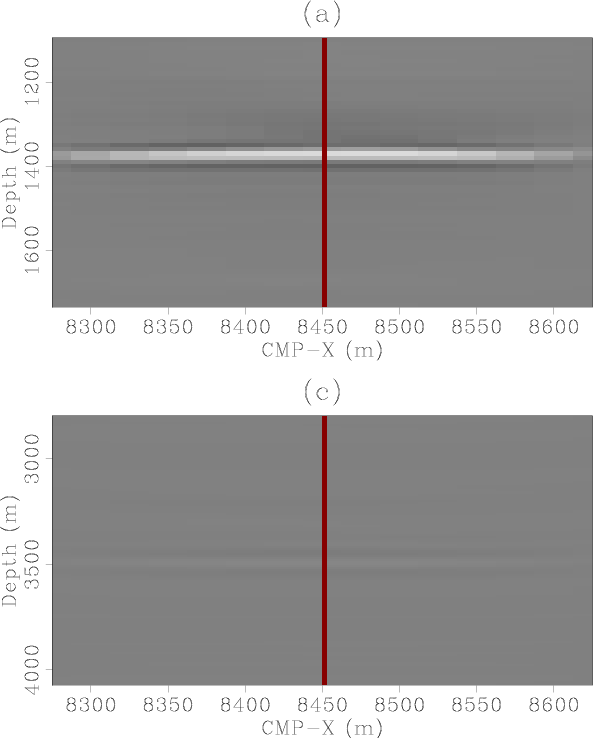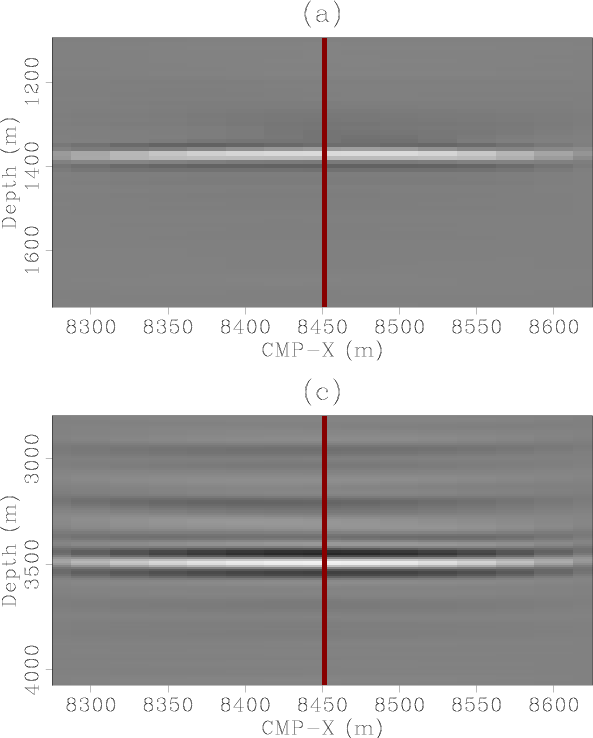Next: Stack of selected azimuths
Up: Azimuth Illumination
Previous: Azimuth Illumination
I start by stacking the 3D ADCIGs for the multiple and the primary over all
azimuths and aperture angles. The result should be their migrated images.
Figure 23 shows a comparison of the stack cubes of the
primary and the water-bottom multiple. Panel (a) is the inline stacked section of the
primary at crossline CMP-Y=1500 m. Panel (b) is the crossline stacked section of
the primary at inline CMP-X=8450 m. Panel (c) is the inline stacked section of the
multiple taken at crossline CMP-Y=462.5 m and panel (d) is the crossline stacked
section of the multiple taken at inline CMP-X=8450 m. All panels are clipped at the
maximum amplitude of the primary which would have been the case if they would have
both been in the same panel. Notice that the vertical
scale is not the same for both panels nor is the scale of the crossline axis.
While the primary and the multiple appear to have the same dip in the crossline
direction, the dip of the multiple is about twice greater. The multiple looks so
washed out because its maximum amplitude is only about one twentieth the maximum
amplitude of the primary. Figure 24 shows the same
figure but with panels (a) and (b) clipped at maximum amplitude of the the primary and
panels (c) and (d) clipped at the maximum amplitude of the multiple so that we can
assess better the character of the multiple.

|
|---|
full-az-stack-clip1
Figure 23. Stack over reflection azimuth and aperture angle
of the 3DADCIGs computed for the water-bottom primary (panel (a)) and the water-bottom
multiple (panel (b)). All panels clipped at the maximum amplitude of the
primary.
|
|---|
![[pdf]](icons/pdf.png) ![[png]](icons/viewmag.png)
|
|---|

|
|---|
full-az-stack-clip2
Figure 24. Stack over reflection azimuth and aperture angle
of the 3DADCIGs computed for the water-bottom primary (panel (a)) and the water-bottom
multiple (panel (b)). Panels (a) and (b) clipped at the maximum amplitude of the
primary. Panels (c) and (d) clipped at the maximum amplitude of the multiple.
|
|---|
![[pdf]](icons/pdf.png) ![[png]](icons/viewmag.png)
|
|---|
Next: Stack of selected azimuths
Up: Azimuth Illumination
Previous: Azimuth Illumination
2007-10-24

